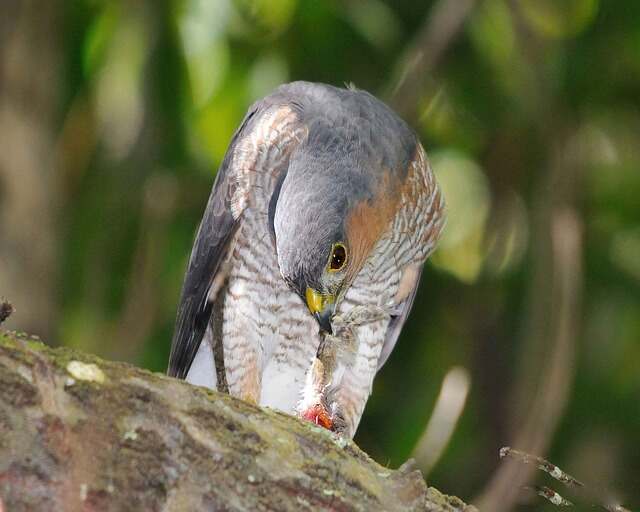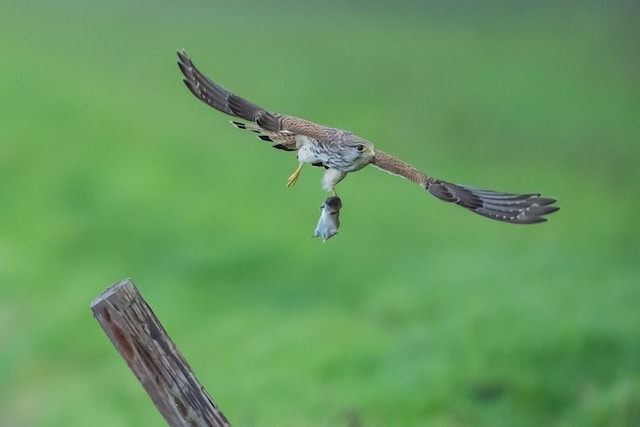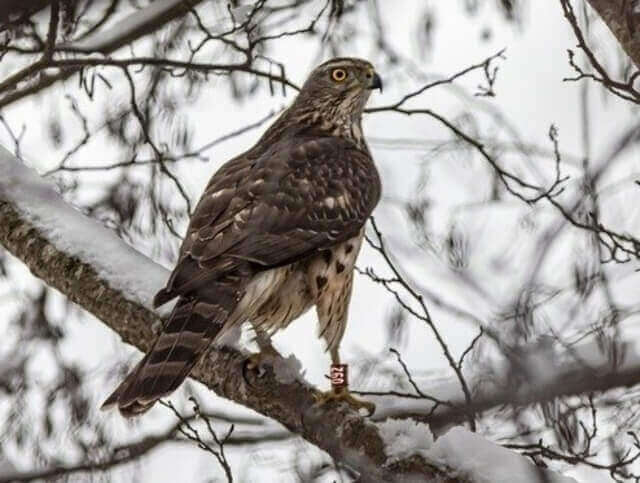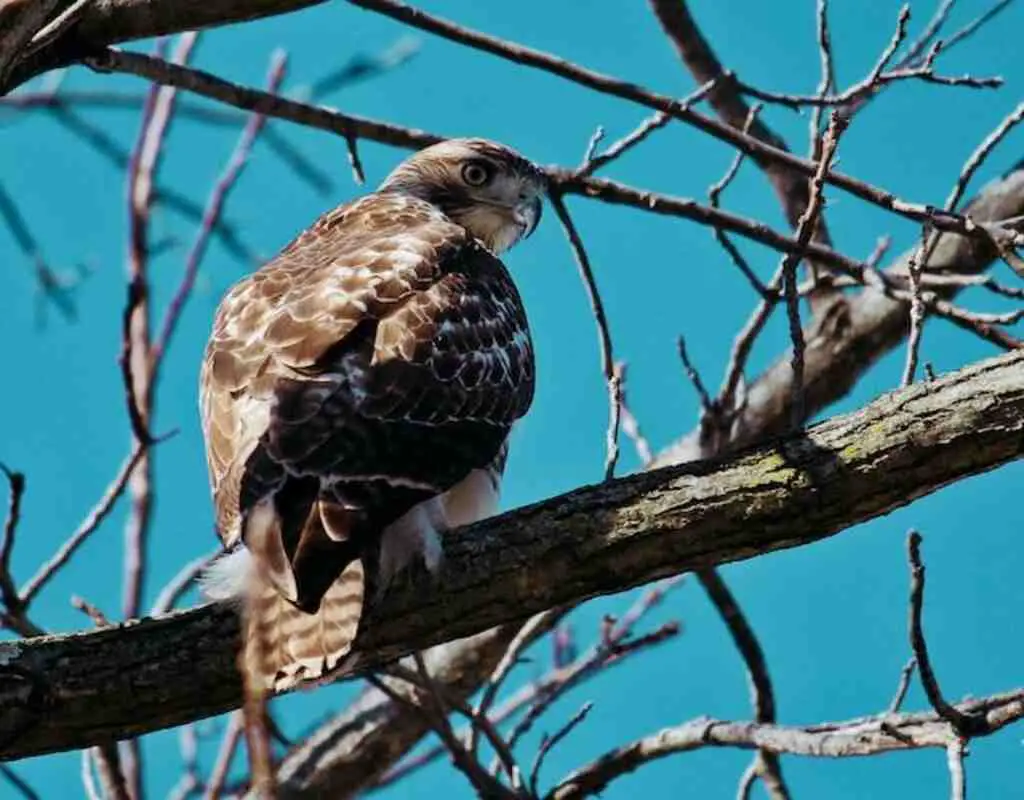How Do Hawks Adapt To Their Environment? Prepare to be captivated by the awe-inspiring world of hawks – the charismatic masters of the skies!
With approximately 270 species found across the globe, these remarkable birds of prey boast sharp talons, unparalleled eyesight, and impressive aerial prowess.
Join us on an exhilarating exploration of how hawks have perfected the art of adaptation, turning them into formidable hunters in their diverse habitats.
Get ready for an adventure like no other!
Table of Contents [show]
Definition of Hawks
Hawks belong to the family Accipitridae, which includes other birds of prey such as eagles, kites, and harriers.
They are characterized by their sharp talons and hooked beaks that help them catch and kill their prey.
Hawks come in a variety of sizes, ranging from small species like the Sharp-shinned Hawk to large ones like the red-tailed hawk.

Importance of Adaptation in the Animal Kingdom
Adaptation is a crucial aspect of survival in the animal kingdom. It allows animals to adjust to changes in their environment and helps them compete for resources more effectively.
Over millions of years, animals have evolved various physical and behavioral adaptations that enable them to survive in different habitats.
Hawks are no exception when it comes to adapting to their environment.
They have developed unique physical traits such as sharp talons and beaks for hunting prey, as well as excellent eyesight for spotting targets from up high.
Overview of How Hawks Adapt to Their Environment
Hawks employ three main types of adaptation: physical adaptations, behavioral adaptations, and habitat adaptations.
Physical adaptations include features such as sharp talons for grasping prey tightly or aerodynamic body shapes that allow hawks to fly more efficiently.
Behavioral adaptations involve hunting strategies such as soaring or stooping techniques used by some species when hunting small mammals or insects on the ground below them.
Nesting habits can also be considered a behavioral adaptation; hawks build nests high up on trees or cliffsides, where they can keep an eye on their territory.
Habitat adaptations involve living in a range of environments, from forests to deserts and grasslands.
Hawks are known for their ability to adapt to changes brought about by human activity, such as urbanization or deforestation.
They coexist with other animals in their ecosystem and have learned to thrive despite the ever-changing landscape.
In the following sections, we will explore each of these types of adaptation in greater detail and learn how hawks have become one of the most adaptable species in the animal kingdom.
How Do Hawks Adapt To Their Environment
Hawks adapt to their environment through physical, behavioral, and habitat adaptations. They have sharp talons, excellent eyesight, and strong wings for efficient flight.
They use hunting strategies, build nests in trees or cliffs, and follow food sources during migration. Hawks thrive in various habitats and can adapt to changes caused by human activity.
Their ability to coexist with other animals and control populations contributes to ecosystem balance. Hawks’ adaptability makes them formidable hunters and ensures their survival in diverse environments.

Physical Adaptations
Sharp Talons for Hunting Prey
Hawks are known for their sharp and strong talons, which are used to catch and kill prey. These talons have a curved shape that allows hawks to maintain a tight grip on their prey, even as they fly through the air.
The talons are also strong enough to pierce through the thick skin of larger prey, such as rabbits, squirrels, and even snakes.
In addition to their sharpness, hawk talons also have serrations or ridges along the edge of each claw.
These serrations help hawks hold onto slippery or wriggling prey securely.
Some species of hawks also have an extra-long back claw or “hallux,” which they use to grasp onto branches while hunting.
Excellent Eyesight for Spotting Prey from Afar
Hawks have exceptional eyesight that helps them spot potential prey from high up in the sky. Their eyes are among the sharpest in the animal kingdom, with some species able to see eight times better than humans.
This keen vision is due in part to a higher density of cone cells in their eyes. Hawks’ eyes are also designed for distance viewing and can focus on objects several hundred yards away.
They can detect slight movements as well as changes in color that may indicate potential prey. This ability is especially useful when hunting from high altitudes or perches.
Strong Wings and Aerodynamic Bodies for Efficient Flight
Hawk wingspans vary by species but can range from two to four feet long. Their wings are broad and sturdy, allowing them to soar through the air effortlessly without expending too much energy.
In addition, hawk bodies are aerodynamically designed with streamlined heads and necks that reduce wind resistance while flying.
They also have powerful chest muscles that help them flap their wings for bursts of speed or when flying in strong winds.
Hawks’ wings also have a unique shape called “elliptical” that allows for more precise and agile flight. This is particularly useful when chasing prey or navigating through tight spaces, such as forests or urban areas.

Behavioral Adaptations
Aside from their physical adaptations, hawks have also developed behavioral adaptations that help them thrive in their environment. These behaviors include hunting strategies, nesting habits, and migration patterns.
Hunting Strategies: Soaring and Stooping Techniques
Hawks are known for their impressive hunting skills. They have developed unique strategies to catch prey efficiently. One of these strategies is called soaring.
Soaring is when a hawk flies above an open area, like a field or a meadow, looking for prey on the ground. Once it spots potential prey, it will swoop down from above to catch it.
Another hunting technique used by hawks is called stooping. A stoop is a high-speed dive towards the ground that can reach speeds of up to 120 mph!
Hawks use this technique to surprise and catch fast-moving prey like birds or rabbits.
Nesting Habits: Building Nests in Trees or on Cliffs
Hawks build nests using sticks, twigs, and other natural materials found in their environment. They typically build their nests high up in trees or on cliffs where they are safe from predators.
The size of the nest depends on the species of hawk and can range from small platforms to large structures almost three feet wide!
The nest-building process starts with both parents working together to construct the foundation of the nest using sticks and twigs.
After that, one parent will stay behind while the other goes out to gather more materials for the nest. The parent left behind will continue building until its mate returns with more materials.
Migration Patterns: Following Food Sources
Hawks are migratory birds that follow food sources throughout different seasons of the year. Some species migrate short distances within North America, while others travel as far as South America during the winter.
The migration patterns of hawks are influenced by the availability of food in their environment.
They will migrate to areas where their preferred prey is abundant. For example, if a certain type of hawk feeds on small rodents like mice, it will migrate to areas where those rodents are plentiful.
The behavioral adaptations of hawks have helped them survive and thrive in their environment.
Their unique hunting strategies, nesting habits, and migration patterns are a testament to their ability to adapt and evolve over time.

Habitat Adaptations
Living in a Variety of Environments
Hawks are known for their versatility when it comes to habitat. They can be found living in a wide range of environments such as forests, deserts, and grasslands.
Different species of hawks have adapted to different habitats based on their specific needs.
For example, the red-tailed hawk thrives in open fields and meadows, while the Cooper’s hawk prefers dense forests with plenty of trees for cover.
Adapting to Changes in Habitat Due to Human Activity
As human activity continues to impact the natural world, many animals struggle to adapt to these changes.
However, hawks have shown impressive adaptability when it comes to changes in their habitat caused by humans.
For instance, some species have been observed nesting on power lines or telephone poles instead of trees.
Additionally, some urban-dwelling hawks have adapted by learning how to hunt pigeons and other city birds.
Coexisting with Other Animals in Their Ecosystem
Despite being skilled hunters themselves, hawks also play an important role in their ecosystem by controlling populations of smaller animals such as rodents and insects.
They are also preyed upon by larger animals such as eagles and owls, so they must keep a watchful eye out at all times while hunting or resting.
Influence on Ecosystems
The presence of hawks can greatly impact ecosystems through controlling populations of small animals that might otherwise overpopulate an area. This helps keep balance within these ecosystems and promotes healthy growth for all organisms involved.
Threats and Protection Strategies
Unfortunately, some human activities pose significant threats to hawk populations.
These include habitat destruction, illegal hunting (such as shooting birds for sport), poisoning from pesticides or lead bullets (which can be ingested by hawks when they eat prey that has been shot with lead ammunition), and collisions with vehicles.
To combat these threats, conservation organizations work to protect hawk habitats, provide education about the importance of hawks in their ecosystems, and enforce laws that protect birds of prey.
Hawks are incredibly adaptable animals that have shown remarkable resilience when it comes to changes in their habitat caused by human activity.
Their ability to thrive in a wide range of environments while coexisting with other animals within their ecosystem make them a vital component of many natural communities.
However, as humans continue to impact the natural world, it is crucial that we take steps to protect these magnificent birds and ensure they will be able to adapt for generations to come.

Conclusion
After examining the physical, behavioral, and habitat adaptations of hawks, it is clear that they are incredibly adaptable creatures.
These birds of prey have evolved to survive in a range of environments, from deserts to forests to grasslands.
Their physical adaptations, such as sharp talons and excellent eyesight, allow them to hunt efficiently and effectively.
Their behavioral adaptations, including hunting strategies and nesting habits, ensure their survival even in harsh conditions.
Their ability to adapt to changes in their habitat due to human activity helps them thrive in new environments.
The importance of adaptation cannot be overstated when it comes to survival in the animal kingdom.
Hawks are a prime example of this truth – they have been able to thrive for millions of years by adapting to changing conditions over time.
Without these adaptations, hawks would not be able to feed themselves or reproduce effectively.
As such, adaptation is not just a helpful tool – it is an absolute necessity for survival. The adaptability of hawks is truly remarkable.
Thanks to their physical and behavioral adaptations as well as their ability to adapt over time and coexist with other animals in their ecosystem while adjusting themselves with human activities like urbanization or agriculture development has allowed these birds of prey species to withstand environmental pressures throughout history.
It’s fascinating how they have evolved into skilled hunters that can survive almost anywhere on earth.
Their ability serves as an inspiration for humans who are facing challenges similar challenges with the environment’s changing conditions around us today.
It is through our own adaptive skills that we will be able to overcome those challenges and ensure our own survival, as well as protect other living organisms who share this planet with us.

FAQs: How Do Hawks Adapt To Their Environment?
How do hawks hunt and catch their prey?
Hawks use their sharp talons to grasp and kill prey while in flight, relying on their exceptional eyesight to spot potential targets from high altitudes.
What physical adaptations do hawks have for hunting?
Hawks have sharp talons for gripping prey, excellent eyesight for spotting prey from afar, and strong wings and aerodynamic bodies for efficient flight during hunting.
What are some behavioral adaptations of hawks?
Hawks employ hunting strategies like soaring and stooping techniques, build nests in trees or on cliffs, and follow migration patterns based on food availability.
How do hawks adapt to different habitats?
Hawks can be found in a variety of environments, such as forests, deserts, and grasslands, adapting to each habitat’s specific conditions and resources.
How do hawks adapt to changes caused by human activity?
Hawks have been observed nesting on power lines, hunting city birds, and adjusting to urbanization and deforestation, showcasing their ability to adapt to human-altered environments.
Do hawks coexist with other animals in their ecosystem?
Yes, hawks play a crucial role in their ecosystem by controlling populations of smaller animals like rodents and insects, while being preyed upon by larger animals themselves.
How do hawks impact ecosystems?
Hawks help maintain balance within ecosystems by controlling populations of small animals, preventing overpopulation, and promoting healthy growth for all organisms involved.
What are the threats to hawk populations?
Hawk populations face threats such as habitat destruction, illegal hunting, poisoning from pesticides or lead bullets, and collisions with vehicles.
How are hawks protected and conserved?
Conservation organizations work to protect hawk habitats, educate about their ecological importance, and enforce laws to safeguard these birds of prey.
What can we learn from hawks’ adaptability?
Hawks’ adaptability showcases the importance of adaptation for survival, inspiring us to develop our own adaptive skills to overcome challenges and protect the environment for all living organisms.



